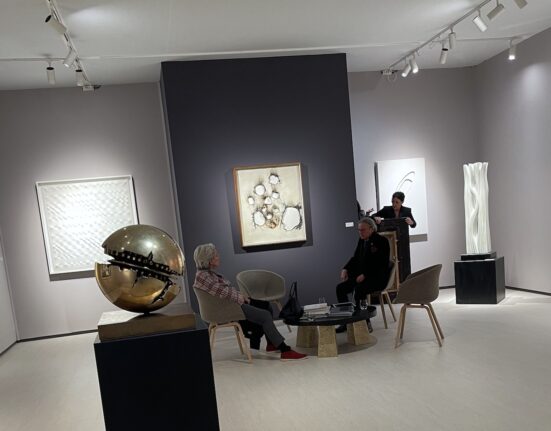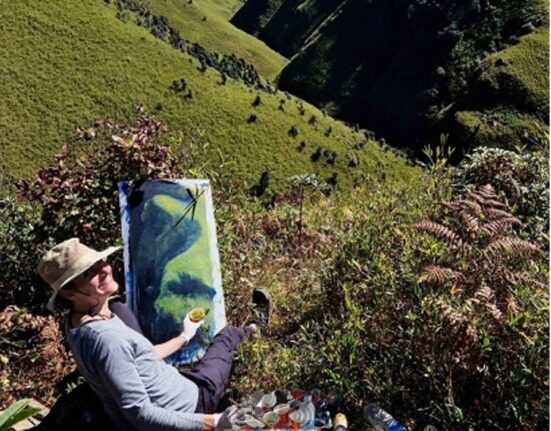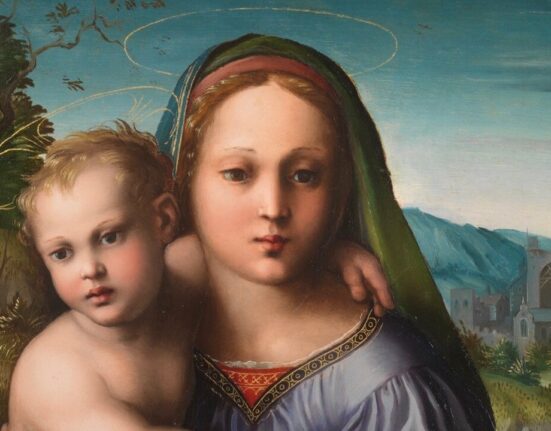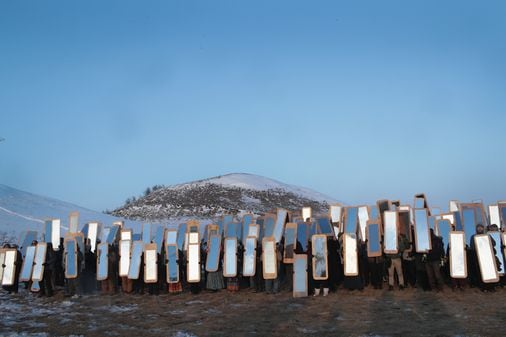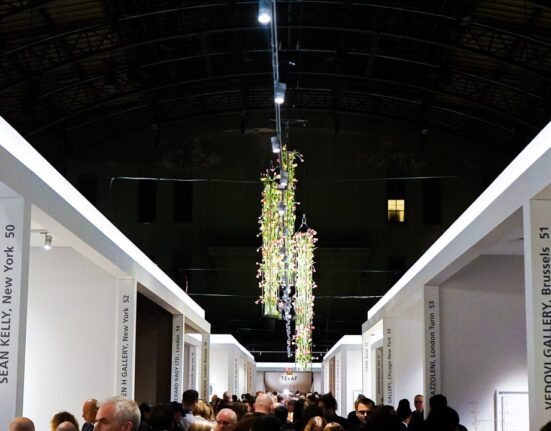Celebrating the iconic resort that changed the Strip 25 years ago.

In 1971, the New York Times called the Italian village of Bellagio a “quiet alternative to the modern, brash resort,” so it’s easy to see how this tiny lakeside destination inspired an iconic Las Vegas hotel that aimed to balance excess with elegance 27 years later. “Quiet” may be a stretch, but the Bellagio we know and love on the Strip today has a timeless, restrained charm despite being the ninth-largest hotel in town with nearly 4,000 rooms and suites.
The Bellagio turned 25 years old this year, celebrating the milestone at the same time Formula 1 grandstands are blocking its most famous feature—the water fountains that erupt from its own version of Lake Cuomo out front. The irony is difficult to ignore, but the scene magnifies the resort’s confident, calm presence, even as Las Vegas continues to evolve around it.
“What we were 25 years ago is what we are today,” Rhonda Povelko, Bellagio entertainment manager, said. “We’re always looking to grow, we’re always looking to improve, but the Bellagio has never taken away that feeling of home.”
Jean-Georges Vongerichten, the French chef behind Prime Steakhouse, describes the Bellagio another way, saying, “It’s still the grande dame of Las Vegas.”
It’s now hard to imagine the Strip without the Bellagio, which bridged the era of Las Vegas as a value-driven travel destination with one of opulence, indulgence, and higher prices. “Gaming became upscale entertainment,” according to chef Michael Mina, reflecting on the resort’s impact upon opening in 1998. “The Bellagio had an effect on the world.”
Beyond the restaurants, casino floor, and hotel rooms, the Bellagio represents a new version of Las Vegas, identifiable in every corner, from the Mediterranean-inspired pool deck to a row of upscale boutiques that helped introduce brands like Tiffany & Co., Chanel, and Giorgio Armani to Las Vegas. Yet the Bellagio is as intriguing and relevant as ever, whether it’s new attractions like the private dining table inside the Conservatory & Botanical Gardens or a secret bar that’s giving new life to vintage spirits.
There’s always something compelling to explore at this 156,000-square-foot hotel, including a legacy dating back 25 years. So let’s take a deep dive into all the stuff you never knew or might’ve forgotten about the Bellagio over two-and-a-half decades in Las Vegas.
It started with a pirate attack
The Bellagio was built by Steve Wynn, who believed that bigger was almost always better. The casino mogul dramatically expanded the Golden Nugget in the ’70s and ’80s, making it the largest hotel on Fremont Street, then famously ushered in the era of the megaresort on the Strip with the Mirage in 1989.
Wynn built the Bellagio on the site of the Dunes, which was imploded in a fireball tied to the 1993 opening of Wynn’s Treasure Island, where the in-house pirate show shot off a cannon to “ignite” the eruption. A year later, the implosion was the climax of Treasure Island: The Adventure Begins, a truly awful NBC television special featuring Wynn himself in a starring role.
The Dunes’ iconic 180-foot-tall pylon, the tallest freestanding sign in the world at one point, was lost in the demolition. (This was long before the Neon Museum preserved and protected this sort of stuff.) According to Las Vegas Then and Now by Su Kim Chung, the sign was built with three miles of neon tubing, creating a deep red glow that was hard to ignore by those staying in the Strip-facing hotel rooms (History repeated itself as the Sphere’s glow is currently keeping hotel guests up.)
The original idea for the Bellagio ended up in Mississippi
The Bellagio was initially announced as Beau Rivage (“beautiful shoreline” in French) with the resort envisioned in the middle of a 50-acre lake and accessible by bridge. After vacationing in Northern Italy, Wynn scrapped his design plans, shifted to an Italian theme, and renamed the resort after Bellagio, a town known for waterside serenity and timeless, historic architecture.
The mogul saved the original name and repurposed it for Beau Rivage in Biloxi. The 1,740-room hotel tower even sort of looks like the Bellagio and remains the tallest building in Mississippi to this day. It was also the largest US hotel outside Nevada when it opened in 1999. The casino was built on barges due to laws then in place that only allowed gambling at sea and was seriously damaged during Hurricane Katrina. After extensive repairs, the resort reopened exactly one year after Katrina struck.
The Bellagio’s exterior is an illusion
The Bellagio was designed by Jon Jerde, who was instructed to give the resort a boutique feel despite being more than 500 feet tall and 36 stories with at least 3,000 hotel rooms (as detailed in The Strip: Las Vegas and the Architecture of the American Dream by Stefan Al). The architect used a favorite trick among hotel designers, grouping four windows together with the appearance of being one single window when viewed from a distance. Using this optical illusion, the Bellagio seems to be just 16 stories. Other Las Vegas hotels, including Caesars Palace and Treasure Island use a similar sleight of hand.
Windsurfing was once planned for the Bellagio’s lake
It’s safe to say the Fountains of Bellagio are the resort’s most well-known feature and attraction. More than a thousand nozzles project water up to 460 feet in the air, dancing and swaying in synchronized light and music shows that run every half hour in the afternoon and every 15 minutes at night, weather permitting.
Originally, Wynn wanted his version of Lake Cuomo to offer water skiing and wind-surfing. Plans changed, and the 8.5-acre lake evolved to be something better for viewing than swimming–although some have tried. Today, 30 certified divers maintain the fountains and collect whatever coins tourists toss in the lake, which are then donated to charity.
The Bellagio ushered in a new era of fine dining
The Bellagio set a new standard for fine dining back when cheap deals and loss-leader buffets dominated Vegas. Jean-Georges Vongerichten (Prime), Julian Serrano (Picasso and later Lago), and Michael Mina (whose self-titled seafood restaurant was originally called Aqua) have been on board since the Bellagio opened, making restaurants attractions in their own right instead of a place to eat between a slot machine and a show. However, people were still on the go in the early days, and some of the restaurants used lunch systems for dinner because people wanted to get through their meals much faster than they did in other cities. The Bellagio also brought in a version of New York’s legendary Le Cirque, which is still going strong today after the original closed in 2018.
There were two nightclubs at one time; now there are none
Even the Bellagio wasn’t immune to the bottle service boom of the early aughts. Light Nightclub opened in 2001, drawing the same younger demographic courted by a revived Studio 54 at the MGM Grand. The 11,170-square-foot space became Bank Nightclub, which enjoyed an 11-year run before closing in 2018. The club had a distinctive glass-encased dance floor, tiered VIP booths, and was one of the first places to feature Bruno Mars in Las Vegas.
Hyde Bellagio was a little smaller at 10,000 square feet, with more of a lounge vibe and an intimate open-air dance floor that overlooked the lake. You could even feel a touch of mist in the air during fountain shows. The venue was most famous for offering a $250,000 high-roller package that included a 30-liter Ace of Spades champagne bottle and permission to activate the fountain with a touch of a button. After seven years, Hyde Bellagio was replaced by Mayfair Supper Club, with nightlife trends drifting away from crowded dance floors, cranberry vodkas, and late-night DJs and toward seated dinners with wine, craft cocktails, and live entertainment. The Hyde brand lives on in Vegas with a lounge on the top level of the T-Mobile Arena.
The Bellagio introduced art to Vegas casinos
Back in the day, most casinos avoided fancy decorations, believing they drew attention away from table games and slot machines. The Bellagio helped change that perception with a fine art gallery to show off Steve Wynn’s private $300 million collection. According to A Short History of Las Vegas by Barbary and Myrick Land, visitors could book appointments to see works by Picasso, Van Gogh, Gauguin, Matisse, Cezanne, Monet, and Renoir with Wynn’s own recorded voice, providing a guided tour of the exhibit.
When MGM Resorts took over the property, Wynn reclaimed his art collection, which was technically leased to the Bellagio. A year later, the gallery was hosting Picassos, Hockneys, Lichtensteins, and Seurats, owned by Steve Martin with the actor’s voice replacing Wynn’s on the audio tour. The gallery has since expanded, changed its location to be more centrally located, and now uses a ticket system for rotating art presentations.
At least eight people clean Fiori di Como every morning
Fiori di Como is the Bellagio’s most famous art decoration, covering more than 2,000 square feet on the ceiling of the check-in lobby. Wynn commissioned Dale Chihuly to create the 50,000-pound piece, featuring more than 2,000 hand-blown glass flowers on a backlit steel frame. The artist earned $10 million for the job. You don’t want to see something this expensive collect dust, so a team of eight-to-10 engineers cleans the sculpture every morning.
A fake elevator was built for Ocean’s Eleven
The 2001 remake of Ocean’s Eleven, a heist film about breaking into the Bellagio, was inspired by the 1960 Rat Pack movie of the same name—and both flicks are quintessentially Vegas. The production crew was given 24-hour access to shoot on location at the resort, thanks to a good relationship between producer Jerry Weintraub and both Steve Wynn (who signed off on the deal) and Kirk Kerkorian (who was in charge when the five weeks of filming took place). A few scenes will look unrecognizable to those familiar with the Bellagio today. An elevator facade built in front of the box office was only temporary and a grand staircase used by Julia Roberts near the Conservatory was removed a couple of years later. You’ll also get a glimpse of the original Bellagio Gallery of Fine Art before it was relocated.
O was originally called Eau
It’s easy to wonder why O by Cirque du Soleil is named after a single alphabetical letter. The show was originally going to be called “Eau” (French for water). The word is pronounced the same way (“oh”), but Bellagio executives feared Americans would call it “eww”—and of course, nobody wanted that. The theater was designed to resemble a 14th-century European opera house with divers, dancers, acrobats, and others performing in and around a 1.5 million-gallon pool.
O, which has more Olympians in the cast than any other Cirque show, has been a hit since day one. Ticket demand was so immense that a third-party service in Canada was hired to handle the call volume with at least 100 people on the line at any given time. (This was before online ticket sales became the norm.) O has sold more than 19 million tickets over 25 years with around 12,000 total performances–and counting.
Dozens of horses were kept outside
Cheval (French for “horse”) was a new production by Cirque du Soleil co-founder Guy Gilles Ste-Croix that ran in Las Vegas in late 2001 and early 2002. The show featured 30 horses, 27 performers, and a live orchestra in a 70,000-square-foot big-top tent that stretched across Harmon Avenue between the Bellagio and Monte Carlo (now the Park MGM). That seems like a huge amount of space to cover, considering the Cosmopolitan and entire CityCenter complex are all squeezed in there today. Cheval was a different kind of equestrian show, earning positive reviews for a Cirque-esque mix of drama, romance, comedy, and acrobatics with 17 breeds of horses appearing throughout 90 minutes.
Flowers are changed every week at the Conservatory
About 15,000 people visit the Bellagio Conservatory & Botanical Gardens, which—like the resort’s fountains—are one of the best free attractions in Las Vegas. Roughly 80 horticulture team members are responsible for elaborate seasonal floral displays, which change five times a year. Traditionally, new exhibits arrive in time for spring, summer, fall, the winter holidays (with a towering 42-foot-tall white fir as the centerpiece), and the Lunar New Year. A floral display of the US flag was displayed for an extended period following the 9/11 terror attacks in 2001. There are anywhere from 12,000 to 25,000 thousand plants and trees in any given exhibit. Individual plants are replaced every week, meaning an exhibit can have up to 60,000 of them over the duration of its run.
The Bellagio hosted a UFC event
It may seem a touch off-brand, but the Bellagio actually hosted the Ultimate Fighting Championship back in 2002 with UFC 37.5: As Real As It Gets, which Sherdog called “one of the UFC’s strangest events” in history. The decimal point is because the UFC already scheduled UFC 38 for a high-profile UK debut a month later and put this fight card together at the last minute for a promotional collaboration with Fox Sports Net. Without an arena on property, the Bellagio held the event inside the convention hall with the caged octagon built over a ballroom carpet. The main event saw future Light Heavyweight Champion Chuck Liddel earn a decision victory over Vitor Belfort.
UFC 37.5 was also the first UFC show to feature Joe Rogan on commentary and the first UFC show broadcast on network TV in Brazil, the home country of jiu-jitsu, which heavily influenced the modern era of Mixed Martial Arts. The Bellagio dabbled further in combat sports with boxing and K-1 kickboxing events over the years.
The Bellagio’s influence is felt in Asia
Nobody talks about it much, but there’s actually a second Bellagio in China—and it looks nothing like the original. Bellagio by MGM Shanghai has less than 200 rooms on the waterfront near the Huangpu River in Shanghai’s historic Bund district. No fountains, conservatory, or even a casino. This is basically a branding agreement in name only with Suning Real Estate Group. The hotel’s stern concrete exterior will do nothing to remind you of Northern Italy, but it does have a version of Lago by Julian Serrano.
Steve Wynn’s Macau resort, the 1,706-room Wynn Palace, is a better representation of the Bellagio’s influence and legacy in Asia. The luxury hotel opened on the Cotai Strip (often compared to the Vegas Strip) in 2016 with a lake and fountain show that was clearly influenced by Wynn’s old Bellagio property.
The Bellagio was the last hotel built by Mirage Resorts
Wynn built the Bellagio for $1.6 billion (or nearly $3 billion when adjusted for inflation today), making it the most expensive hotel in the world when it opened. The property struggled to be profitable, but things turned around after Wynn’s Mirage Resorts merged with MGM Grand, Inc., forming MGM Mirage and later MGM Resorts International. The new ownership eventually turned the Bellagio into the most profitable hotel in the world and added a second tower with nearly a thousand additional rooms in 2004—a year before Steve Wynn would open his own self-titled Wynn Las Vegas resort farther north on Las Vegas Boulevard.
The Bellagio was sold to private equity firm Blackstone, with MGM Resorts still operating the resort under a leasing agreement. Realty Income recently purchased a 22% stake from Blackstone in a deal that now values the property at more than $5 billion. And really, this might be the Bellagio’s greatest legacy—kicking off an era of leverage, assets, and deals so complex, the general public barely understands who actually owns the place when it’s all said and done. Welcome to the new Las Vegas.


